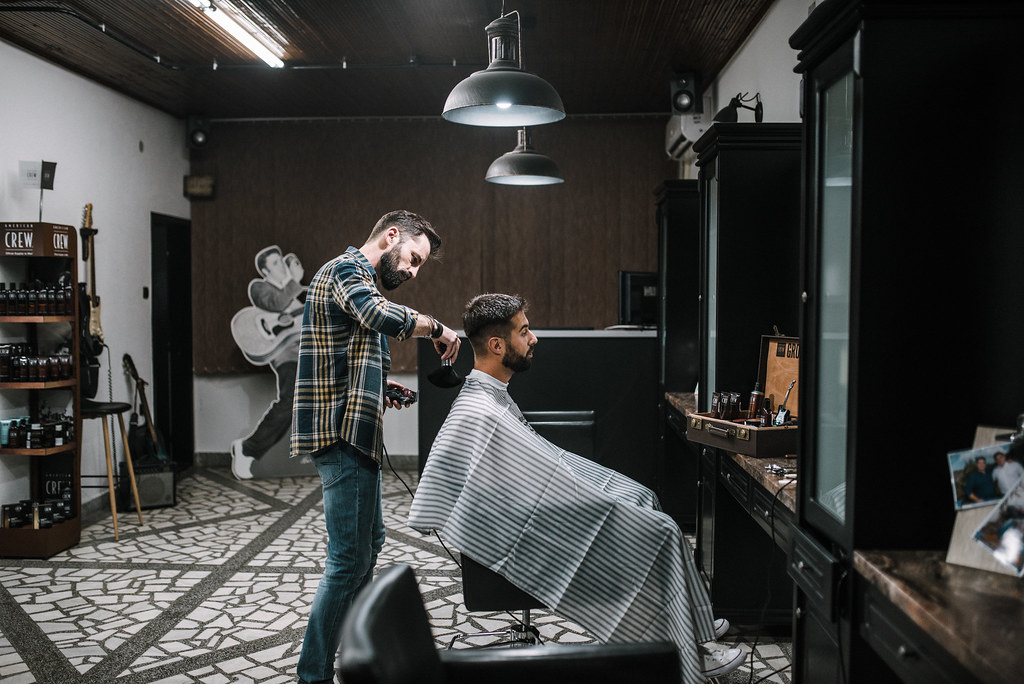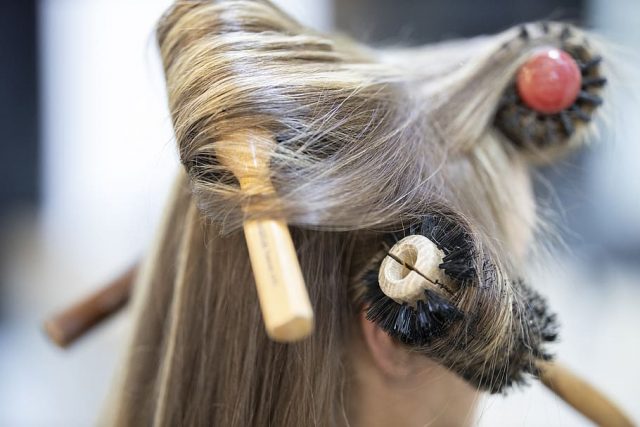Before my sitting disability spun out of control, I used to visit a charming hair salon that was a short walk away from my apartment. The salon didn’t have a website, or a Google business page, or posted hours, or air conditioning, or bathrooms. I’m not completely sure they had a working phone. They did have walls crowded with expired products, and a pink sandwich board that they set outside when they were open.
Before I’d go, I’d pick a Pinterest photo to illustrate the kind of haircut I wanted. This was a mere formality, as none of stylists cared which photo I showed them. One female stylist would give me a look that said, What the Hell is wrong with you?
The male stylist would cock his head contemplatively while I described the cut I had in mind. This was purely out of politeness. None of the stylists spoke a word of English, and I didn’t speak Spanish. When we communicated at all, it was through hair-themed charades.
After ignoring my request, the on-duty stylist would give me whatever cut he or she felt I deserved. It was always better than the pictures I showed them, anyway. The language barrier discouraged any awkward attempts at conversation, so I was free to relax in the chair. At the end, they’d hand me my glasses, I’d hand them a wad of cash, and we’d go our separate ways.
When my sitting disability bloomed into its all-consuming glory, I stopped visiting that salon. I stopped visiting any salons. My Mom would cut my hair short whenever I saw her, which averaged twice a year. The rest of the time, I’d let it grow. I thanked my lucky stars that I was a girl, and I could grow out my hair for nine months at a time without anybody caring.
Every time I passed the salon and looked through its windows, I shuddered as I imagined folding myself into an adjustable chair. Looking back, I’m embarrassed to admit that I was so focused on managing my own pain that it never occurred to me that the stylists might be dealing with worse.
There was a decent chance that they were. One small survey from New Zealand revealed that 50% of practicing hairdressers had suffered an overuse injury in the past five years, while 10% had experienced dermatitis. A study of Finnish hairdressers suggested that health problems greatly increased the chance that hairdressers would leave the profession.
Ergonomics and occupational health experts have long realized that hairdressers and stylists face unique hazards and physical stresses at work, and several governments (including the EU and Canada) and have weighed in on the risks.
Hairdresser Working Conditions
One of the enviable aspects of hairdressing work (which may simply be a grass-is-always-greener perception) is that hairdressers are very often self-employed, or work in small businesses. A 2014 report from EU-OSHA says that, “Hair salons have, on average, fewer than three workers, and are, for the vast majority, run by self-employed hairdressers who often work on their own (without dependent employees). The share of self-employment in the sector appears to be two to ten times higher than in the whole of the economy.”
On the not-so-enviable flipside, mobile hairdresser work (for example, workers who specializing in styling hair for weddings) sounds torturous to my sitting-disabled self. The EU report also notes that, “Pay levels are generally lower than the national average in most countries. The high rate of hairdressing activities in the illegal economy in some EU countries causes substantial problems and downwards pressure on working conditions in the sector.”
Data from U.S. Bureau of Labor Statistics shows that low pay is not just an EU phenomenon. In the U.S., hairdressers earn a mean annual wage of $31,530, compared to $53,490 for all workers.
Hairdresser Hazards

You don’t have to be a doctor to realize that the combination of toxic chemicals, physically demanding work postures, and the frequent use of very hot tools is not a recipe for health and safety. Hairdressers are uniquely predisposed to health problems like:
- Skin problems (It turns out that frequent handwashing and hair-washing, combined with the frequent use of strong chemicals is not good for your hands.)
- Asthma
- Repetitive motion injuries
- Shoulder, wrist, neck, and low back pain
- Burns and cuts
- Infectious diseases
- Cancer
Lord knows I am not qualified to write a blog about hair salons, so I won’t go into great detail about most of these. But I list them for two reasons. First, so that you can understand why your hairdresser might be cranky. Second, I read a crap-ton of government documents for this, and I’m determined to get a decent word count.
Musculoskeletal Conditions in Hairdressers
Every country, it seems, has done its own study on musculoskeletal conditions in hairdressers. While the study designs and exact numbers differ, they are largely variations on a theme.
So how many hairdressers get musculoskeletal conditions? The answer is, a lot. The UK’s Institution of Occupational Safety and Health (IOSH) estimates that 40% of hairdressers suffer from some degree of musculoskeletal conditions. Meanwhile, one study of hairdressers in Brazil found that a whooping 71% suffered from the same.
The New Zealand report noted many working postures that can lead to musculoskeletal injuries. Holding the elbow out while cutting hair, leaning over to compensate for poor lighting, or regularly twisting the head can all lead to pain. Problems with the shoulders, wrists, neck, and back are common. Fortunately, they are often preventable if workers use good posture and movement patterns.
Standing is, naturally, a hazard. The EU-OSHA report noted, “Standing for long periods of time can induce problems such as varicose veins, poor circulation and swelling in the feet and legs. In this category of risks manual handling of heavy goods or equipment can be implicated with lower back injuries.”
Suggested interventions for hairdressers include wearing flat-bottomed shoes, and taking frequent breaks. In many ways, the interventions suggested for hairdressers echo the recommendations for other standing-heavy occupations. Notably absent from hairdresser recommendations were antifatigue mats. Reading between the lines, I’d guess that flooring that can easily be swept and mopped is a higher priority than special mats. Also, unlike factory workers, hairdressers are more likely to move frequently among workstations.

Photo by Nenad Stojkovic via Flickr.
It’s the Process That Matters
When I started this little research project, I assumed that ergonomic guidelines for hairdressers could easily be applied to those with sitting disabilities. Alas, It wasn’t that easy. It turns out that the chief scourge of hairdressers is dermatitis. Formaldehyde exposure, likewise, is a major health concern. Sitting-disabled people, unless I’m missing something, are not terribly concerned about either.
Maybe I could coopt some interventions for use among the sitting-disabled? But I was thwarted there, too. Sitting-disabled people, unless they are also hairdressers, are unlikely to benefit from stand-alone washbasins or offset scissors.
But my research was not completely in vain. While the research on hazards and interventions was not terribly enlightening, I did glean some useful information by learning about the the process used to create guidelines.
What impressed me most wasn’t even the process itself. What impressed me was that somebody cared enough to go through it.
The New Zealand guidelines in particular were worthwhile reading. The authors did their homework; they relied on previously published studies, guidelines, and surveys. Then they conducted onsite visits to see what was happening on the ground at salons. They made note of working conditions and professional practices. They called hairdressers, and talked to them on the phone. They consulted with other professionals, such as dermatologists, who might have something to say about the risks.
They used all this information to come up with a simple, readable list of dos and don’ts. They included pictures. The acknowledged what they didn’t know.
EU-OSHA put together a checklist to guide salon owners and hairdressers. It’s less user-friendly than the New Zealand document, but it’s practical and readable. The five-step risk assessment process it outlines is obvious to the point of inanity, and consistent punctuation was low on the priority list, but for government writing it’s not bad.
The Five-Step Risk Assessment Process
Step 1. Identifying hazards and those at risk.
Looking for those things at work that have the potential to cause harm, and identifying workers who may be exposed to the hazards.
Step 2. Evaluating and prioritising risks
Estimating the existing risks (the severity and probability of possible harm…) and prioritising them in order of importance.
Step 3. Deciding on preventive action
Identifying the appropriate measures to eliminate or control the risks.
Step 4. Taking action
Putting in place the preventive and protective measures through a prioritisation plan.
Step 5. Monitoring and reviewing
The assessment should be reviewed at regular intervals to ensure that it remains up to date.
Takeaways for the Sitting-Disabled: A Rant
Sitting disabilities are still relegated to the very fringes of public recognition. To my knowledge, no qualified person has done a comprehensive review of the risks sitting-disabled individuals are exposed to at work. No one has visited sitting-disabled workers to observe them in action. No one has proposed or tested interventions.
No professional or government group has expressed its desire to keep sitting-disabled people in the workforce, or advised employers on how they might do so.
To my pile of wishes, I add: I wish they would.
No sane person would judge hairdressers for developing a skin condition, or for leaving the industry because a shoulder injury makes it impossible to work without pain. No one would say it was the worker’s fault, because she failed to hold a comb the correct way. There would be an understandable cause-and-effect link between profession and injury.
Likewise, sitting-disabled workers should not be faulted for being unable to drive. Ergonomic workstations for reclining workers should be designed to mitigate the risk of spine and wrist problems. Standing options should be available in conference rooms, cafeterias, and other workplaces.
In this blog, I do my best to bring issues related to sitting disabilities to light. But I am only one person, and I lack any sort of official authority to bring change. For real change to be effected, people and groups more powerful than me will need to get involved.
Oh, and if you read this article hoping for a tip about finding a hairdresser when you have a sitting disability, here’s my advice: Find one who’s taller than you are.

One thought on “Ergonomists Care About Hairdressers. Why Not Sitting Disabilities?”